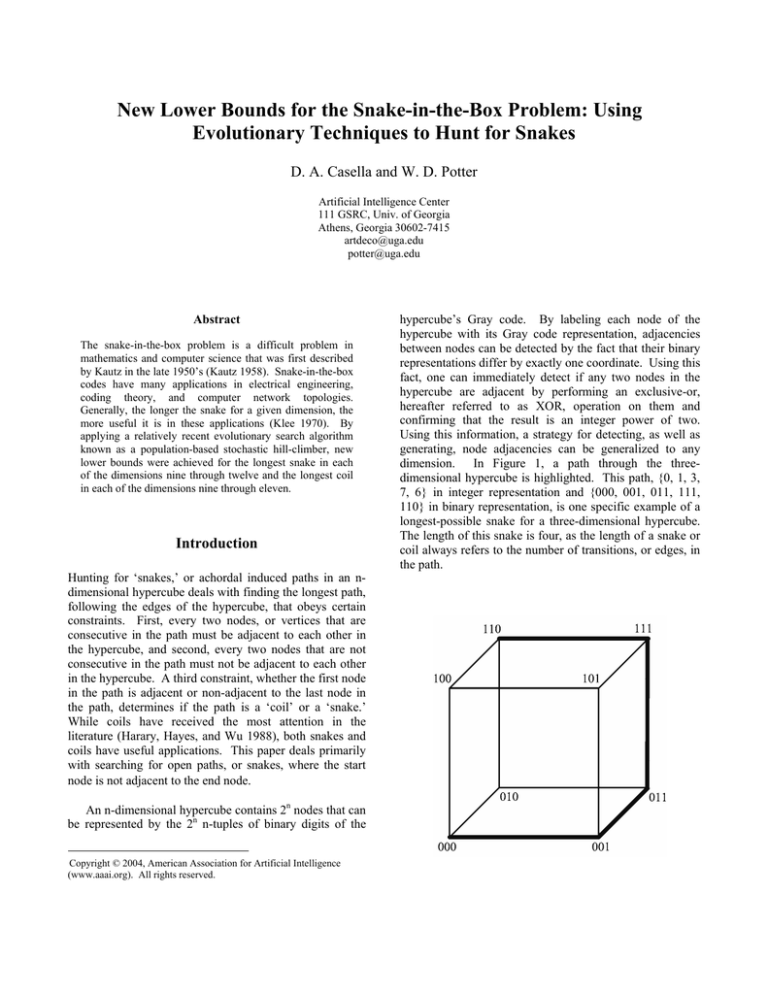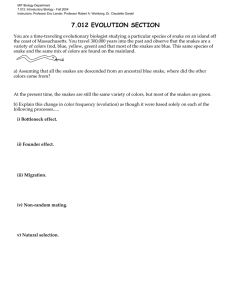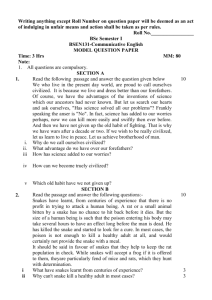
New Lower Bounds for the Snake-in-the-Box Problem: Using
Evolutionary Techniques to Hunt for Snakes
D. A. Casella and W. D. Potter
Artificial Intelligence Center
111 GSRC, Univ. of Georgia
Athens, Georgia 30602-7415
artdeco@uga.edu
potter@uga.edu
Abstract
The snake-in-the-box problem is a difficult problem in
mathematics and computer science that was first described
by Kautz in the late 1950’s (Kautz 1958). Snake-in-the-box
codes have many applications in electrical engineering,
coding theory, and computer network topologies.
Generally, the longer the snake for a given dimension, the
more useful it is in these applications (Klee 1970). By
applying a relatively recent evolutionary search algorithm
known as a population-based stochastic hill-climber, new
lower bounds were achieved for the longest snake in each
of the dimensions nine through twelve and the longest coil
in each of the dimensions nine through eleven.
Introduction
Hunting for ‘snakes,’ or achordal induced paths in an ndimensional hypercube deals with finding the longest path,
following the edges of the hypercube, that obeys certain
constraints. First, every two nodes, or vertices that are
consecutive in the path must be adjacent to each other in
the hypercube, and second, every two nodes that are not
consecutive in the path must not be adjacent to each other
in the hypercube. A third constraint, whether the first node
in the path is adjacent or non-adjacent to the last node in
the path, determines if the path is a ‘coil’ or a ‘snake.’
While coils have received the most attention in the
literature (Harary, Hayes, and Wu 1988), both snakes and
coils have useful applications. This paper deals primarily
with searching for open paths, or snakes, where the start
node is not adjacent to the end node.
An n-dimensional hypercube contains 2n nodes that can
be represented by the 2n n-tuples of binary digits of the
Copyright © 2004, American Association for Artificial Intelligence
(www.aaai.org). All rights reserved.
hypercube’s Gray code. By labeling each node of the
hypercube with its Gray code representation, adjacencies
between nodes can be detected by the fact that their binary
representations differ by exactly one coordinate. Using this
fact, one can immediately detect if any two nodes in the
hypercube are adjacent by performing an exclusive-or,
hereafter referred to as XOR, operation on them and
confirming that the result is an integer power of two.
Using this information, a strategy for detecting, as well as
generating, node adjacencies can be generalized to any
dimension. In Figure 1, a path through the threedimensional hypercube is highlighted. This path, {0, 1, 3,
7, 6} in integer representation and {000, 001, 011, 111,
110} in binary representation, is one specific example of a
longest-possible snake for a three-dimensional hypercube.
The length of this snake is four, as the length of a snake or
coil always refers to the number of transitions, or edges, in
the path.
Figure 1: A Three-Dimension Hypercube with
Embedded Snake
Approaches
Traditionally, mathematical approaches to the snake-inthe-box, hereafter referred to as SIB, problem have
involved two fundamental strategies. The first is a method
of construction utilizing the tools of logic, discrete
mathematics, and graph theory, while the second strategy
uses mathematical analysis to reduce the search-space
followed by a computationally exhaustive search of the
remaining, tractable, search-space. These techniques have
been successful in determining the longest-possible snakes
for hypercubes of dimensions one through seven as shown
in Table 1. For dimension seven, the lower bound for
longest-possible snake (Potter et. al. 1994) was found
independently using both a genetic algorithm and an
exhaustive search, while the lower bound for longestpossible coil (Kochut 1996) was found using only an
exhaustive search.
DIM
SNAKE
COIL
1
2
3
4
5
6
7
1
2
4
7
13
26
50
0
4
6
8
14
26
48
Table 1: Maximum Lengths of Snakes and Coils
But even as mathematical approaches to solving this
problem have been strengthened through the use of
computational techniques, the combinatorial explosion in
the size of the search-space as the dimension number
increases has become a barrier for these methods. For
dimensions eight and above, even with currently available
hardware, an exhaustive search remains impractical. This
has opened the door for less-traditional, heuristic-based
computational search techniques.
One increasingly
popular branch of these search techniques is known as
stochastic search algorithms. This area includes stochastic
hill-climbers, tabu search, simulated annealing,
evolutionary strategies, genetic algorithms, and hybrids of
these particular types such as memetic algorithms.
One example of a stochastic search algorithm that has
been used to hunt for snakes in dimension eight is the
genetic algorithm, hereafter referred to as GA. Developed
by John Holland (Holland 1975), the GA is based on the
simulation of Darwinian evolution and uses an
evolutionary loop composed of fitness-based selection of
individuals from a population, crossover of these
individuals’ genetic material, and mutation of these
individuals’ genes. The GA performs a search-space
reduction through the use of a heuristic in determining the
fitness of an individual within the population and through
the inherent parallelism of a population-based approach.
This technique has met with success and, by finding, what
was at that time, a record-breaking snake in dimension
eight (Potter et. al. 1994), proved its effectiveness for snake
hunting.
Another stochastic search algorithm that has proven
successful in traveling salesperson-type problems, such as
the SIB problem, is the stochastic hill-climber (Kingdon
and Dekker 1995). A population-based stochastic hillclimber, hereafter referred to as PBSHC, is very similar in
structure and operation to the simple GA with a few key
differences in the evolutionary cycle. The first difference
is the absence of a crossover operator. Where the GA
models sexual reproduction, the PBSHC models asexual
reproduction in that the children in each generation are
created directly from the parents of the previous generation
without the exchange of genetic material between them.
The second difference is the addition of a growth operator.
The growth operator is the component that does the actual
‘hill-climbing’ as it chooses randomly from the nodes
available to extend each snake’s path by one edge along the
hypercube. The absence of crossover, broadly considered
the most important operator of a GA, can sometimes leave
the PBSHC at a relative disadvantage. However, due to the
trouble most crossover schemes have in dealing with
adjacencies, the lack of crossover did not seriously degrade
the PBSHC’s performance, relative to the GA, in the case
of the SIB problem.
The Evolutionary Cycle
Each individual in the population consists of a sequence of
integers that represents the node sequence of a snake, or
valid path through the hypercube, in the dimension being
searched. These individuals are initialized as either a snake
of length zero, that is consisting of only the zero node, or
seeded with a pre-existing snake of choice. Following
initialization, the evolutionary cycle begins its first
generation.
Each generation begins with a fitness
evaluation. The fitness function used is based on both the
length of the snake and the ‘tightness’ of the snake. The
tightness of a snake is a measure of how many nodes are
left available in the hypercube after subtracting all those
nodes that are disqualified either by already being in the
snake or by being adjacent to a node, other than the start
node or the end node, that is already in the snake. The
choice of tightness as a component of the fitness function
was inspired by the idea that tighter snakes might tend to
be longer snakes. Since all snakes that were able to grow
in the previous generation have the same length, tightness
becomes the only distinguishing factor of the fitness
function.
After the individual fitness of each of the snakes in the
population is determined, the population is subjected to
selection based upon each snake’s fitness.
Three
fundamental selection types were considered. Preliminary
trials were conducted using roulette-wheel, tournament,
and rank-based selection methods. Roulette-wheel, or
probabilistic selection, proved the least effective, and most
computationally expensive. Tournament selection was
more effective than roulette-wheel at producing longer
snakes, on average, over multiple runs. Rank-based
selection out-performed both roulette-wheel and
tournament selection, by maintaining a more diverse
population throughout the evolutionary cycle. In rankbased selection, after first ranking the population by
fitness, selection takes place based on a set percentage of
the population.
After selection, the growth operator grows each snake
in the population by one step each generation, connecting
each snake’s end node to one of its adjacent nodes that has
not been disqualified by already being in the snake, or by
being adjacent to some node that is in the snake. Both
unidirectional
and
bi-directional
growth
were
implemented, with bi-directional growth allowing each
snake to grow from either end. This operator can be seen
to perform a stochastic hill-climbing process on each snake
in the population as the choice of which adjacent node to
connect to is based on random selection from the available
nodes. A choice was made early to grow all snakes in the
population instead of only the snake of best fitness (note:
typically, enhancing the best individual in a population is a
standard approach used in hybrid genetic algorithms
(Potter et. al. 1992)). This choice was also based on
results of a comparison of these two approaches in an
earlier GA implementation. Growing all the individuals
within the population works well in conjunction with the
fitness function, but does require that all snakes in the
population be of the same length in order to function
properly. The fitness function consists of the sum of the
snake’s length and normalized tightness. This results in
the fitness function simplifying to a function of tightness
alone as the length component of the fitness value will
dominate for snakes of different lengths, yet cancel for
snakes of the same length. This also results in the
automatic elimination of snakes that can no longer grow,
allowing their place in the population to be reallocated to
other snakes that are still capable of growth.
After growth, the mutation operator acts on each snake
in the population. The mutation operator we experimented
with is an enhancement of a basic XOR mutation scheme
(Brown 2004). In the standard XOR mutation scheme, a
node is chosen at random from within the snake, excluding
the start node and the end node. The chosen node’s
neighboring nodes are XOR’d and that result is then
XOR’d with the chosen node in order to exchange it with a
different node that maintains local adjacency requirements
with the original node’s neighbors. The enhancement of
this operator is referred to as iterative-conditional XOR
mutation and is somewhat more computationally
expensive, but also more effective. Instead of choosing a
node at random, each node in the snake, with the exception
of the start node and the end node, is mutated and tested for
any improvement in fitness within a copy of the original
snake. If any improvement is found, that mutation is added
to a mutation pool. Upon testing of all nodes within the
snake, the snake of best fitness from the mutation pool is
substituted for the original snake. If any improvement was
found through mutation, the entire process is repeated until
no further improvement is found. This scheme ensures that
only constructive mutation is allowed, and that undergoing
mutation can never reduce an individual’s fitness. By
making this mutation conditional, it has also become a
‘hill-climbing’ component of the evolutionary cycle.
However, left to iterate without bounds this scheme may
lead to prohibitive runtimes. Restricting the number of
iterations for each original snake to five for example keeps
the advantages of a local hill-climber and also keeps the
runtime under control. It turns out that this enhancement
did not influence our results because the operator was
turned off in order to prevent changes in the high-quality
root-snakes used when seeding results from lower to higher
dimensions.
PBSHC Experimental Setup
The choice of parameter settings was found to be of key
importance to the performance of the PBSHC and these
settings were tuned extensively in dimension eight before
modified to run in dimensions nine through twelve. Our
previous experience with genetic algorithm snake hunters
supported the application of lower dimension parameter
settings to higher dimensions. The fitness function is set to
the sum of length and normalized tightness. Normalized
tightness was defined as the number of nodes remaining
available divided by the total number of nodes in the ndimensional hypercube. Rank-based selection was chosen
in order to maximize diversity within the population.
While both unidirectional and bi-directional growth were
used in the dimension-eight trials, the relatively memoryconservative unidirectional implementation was chosen for
these experiments in order to maximize potential
population sizes for dimensions nine through twelve.
Because this particular implementation’s chromosome size
is constant, the use of unidirectional growth instead of bidirectional growth allowed the required memory for each
population size to be reduced by half.. Population sizes
from one hundred through ten thousand were run in trials
using mutation. Larger populations were prohibitively
time-consuming using mutation, especially for dimensions
eleven and twelve.
Results
The best results to date were achieved using
populations of ten thousand, a selection percentage of
ninety percent, and by seeding each population at startup.
Using a technique where the best snakes found in each
dimension were used as seeds for the next higher
dimension (Potter et. al. 1994), the PBSHC was able to
find snakes longer than the previously known longest
snakes for dimensions nine through twelve. However, to
generate good seeds for dimension nine, a bootstrap
solution was used. This method involved cutting a
dimension-eight, length-97 snake (Rajan and Shende 1999)
back to its length-50 root, corresponding to the longest
snake in dimension seven, and running an exhaustive
search on that snake to generate a pool of seventeen
distinct length-97 snakes. These snakes were then used to
seed the dimension-nine runs. Subsequently, the best
snakes found in each dimension were used as seeds for the
next dimension’s runs. In conjunction with this technique,
mutation was shut off in order to preserve the high-quality
seeds generated from each previous dimension. This also
reduced the runtime allowing larger populations to be run
over a much shorter time-frame.
DIM
PREVIOUS BEST
PBSHC
8
9
10
11
12
97
168
338
618
1236
97
186
358
680
1260
Table 2: Comparison of Best-Known Lower Bounds for
Snakes
In Table 2, for dimension eight, the lower bound for
longest-known snake (Rajan and Shende 1999) was found
using traditional mathematical proof and construction
techniques aided by computational search (i.e.,
construction based on lower dimension long snake
characteristics). For dimensions nine through twelve, the
previous best-known lower bounds were derived by
calculation from the lower bounds for longest-known coils
in each dimension. Any coil can be converted to a snake
by removing one node. This results in a snake whose
length is two less than the original coil, as removing one
node removes the two edges connecting it within the coil.
The previous best-known lower bounds were 168 for
dimension nine (Abbott and Katchalski 1991), and 338,
618, and 1236 for dimensions ten through twelve,
respectively (Paterson and Tuliani 1998). The transition
sequences representing the new lower bounds for longestknown snakes in dimensions nine through twelve are listed
here.
dim 9 : 186
01234532103253123452310326054301
35023103543012502372052413015201
30543520362543013502310354301250
28732453103453152103453013561301
52013054352031762543513253013562
54350135430520154103562350
dim 10 : 358
01234532103253123452310326054301
35023103543012502372054213015201
30543520362543013502310354301250
28732453103453152103453013561301
52013054352031762543513253013562
54350135430520154103562350951078
05210345301320531034526302534503
10251031245081623013254351325301
53603102503423012073421301520130
54352036504532513502354082134503
10235024523103620523142105203120
542856
dim 11 : 680
01234532103253123452310326054301
35023103543012502372054213015201
30543520362543013502310354301250
28732453103453152103453013561301
52013054352031762543513253013562
54350135430520154103562350951078
05210345301320531034526302534503
10251031245081623013254351325301
53603102503423012073421301520130
54352036504532513502354082134503
10235024523103620523142105203120
5 4 2 8 5 6 10 8 7 9 3 2 0 5 2 1 0 3 4 5 3 0 1 3 2 0 5 3 1 0 3
45263025345031025103124508162301
32543513253015360310250342301207
34213015201305435203623103453152
35431821345031023502452310362052
31421052031205427915205430520362
31025302407450235210523543084015
20132630250342052680263025345031
05210312437052061028620362543013
50231035431063201450310253725042
305260342
dim 12 : 1260
01234532103253123452310326054301
35023103543012502372054213015201
30543520362543013502310354301250
28732453103453152103453013561301
52013054352031762543513253013562
54350135430520154103562350935263
02534503102510315620531523543104
71352310235408310345301320531034
53102372054203520130543520164102
51352735103123513054352031284054
32103243052014610236217581520351
8 3 10 9 4 2 1 3 0 1 5 2 0 1 3 0 5 4 3 5 2 0 3 6 2 5 4 3 0 1 3
50231035430125074103253123452310
32605430135023103543012594130543
52036254301350231035430128921034
53013205310345263025345031025103
12450960231025345031023562315234
53013841301537253152015412530263
25345031025103410814532513502354
12903450310251031245231036205430
52031205491450315321301490250912
0 3 6 2 0 11 5 0 9 4 3 0 5 10 6 5 0 3 4 5 0 6 1 7 4 0 2 3 1 0
35430125135430126103123513054352
03128154305201561352310276201305
4 3 5 2 0 3 6 2 5 4 3 0 1 3 5 0 2 6 10 1 3 0 2 5 0 3 4 5 0 2 6
32534503153450740231035430120410
3 4 5 2 6 3 0 2 5 3 4 5 0 3 1 5 3 2 1 3 0 1 5 3 10 2 5 4 6 1 5
3 2 0 1 3 5 6 7 2 4 9 10 2 1 3 0 1 5 2 0 1 3 0 5 4 3 5 2 0 3 6
23520345325135023571352054352012
4 0 2 3 5 6 2 3 1 5 2 0 1 3 4 10 1 3 0 2 5 3 4 5 0 3 1 0 2 5 1
03165310354301204103451823102534
50310235623152031762054814502530
13561325043501926513012509405865
1 3 0 5 4 3 5 2 0 3 6 2 3 5 2 0 3 4 5 3 0 10 9 1 3 2 0 5 4 7 1
45031023562502130250345026301351
43164259413054352036235203453251
3 5 0 2 5 6 1 3 0 1 4 8 5 2 3 1 2 5 0 3 2 1 3 10 8 3 2 4 6 1 3
4 6 0 5 1 10 6 3 2 7 9 0 5 2 1 0 3 4 5 6 2 5 4 3 0 5 4 1 0 5 2
1 0 3 1 2 4 5 0 9 4 5 2 1 4 3 0 1 3 10 6 9 1 4 5 6 3 1 5 4 1 0
3 4 1 2 4 3 5 2 10 8 0 2 5 0 3 4 2 6 3 1 0 3 4
Conclusions
The results of using a PBSHC to search for SIB codes
are very encouraging.
As computational hardware
improves over time, this technique should prove useful in
even higher dimensions. Further improvements using this
implementation of the PBSHC are anticipated including the
return to bi-directional growth, the addition of a mid-snake
growth operator, and a parallel virtual machine
implementation of the PBSHC. Preliminary trials using
this technique to search for coils, or closed paths, have
begun and we have already discovered new lower bounds
for coils in dimensions nine (180), ten (344), and eleven
(630); details to be reported in a future paper.
Acknowledgements
We would like to thank the students and staff of the AI
Center, especially Dr. Michael Covington, for their support
and cooperation with this project. There were numerous
days and nights when the Center's lab computers were
occupied with snake hunting.
References
Abbott, H. L. and Katchalski, M. 1991.
Construction of Snake-In-The-Box Codes.
Mathematica 40:97-116.
On the
Utilitas
Brown, W. April, 2004. Personal Communication.
Harary, F.; Hayes, J. P.; and Wu, H. J. 1988. A Survey of
the Theory of Hypercube Graphs.
Computational
Mathematics Applications 15:277-289.
Holland, J. H. 1975. Adaptation in Natural and Artificial
Systems. Ann Arbor, MI: The University of Michigan
Press.
Kautz, W. H. 1958. Unit-Distance Error-Checking Codes.
IRE Trans. Electronic Computers 7:179-180.
Kingdon, J. and Dekker L. 1995. The Shape of Space. In
Proceedings of the Conference on Genetic Algorithms in
Engineering Systems: Innovations and Applications, 543548. London, UK.: IEE.
Klee, V. 1970. What is the Maximum Length of a dDimensional Snake? American Mathematics Monthly
77:63-65.
Kochut, K. J. 1996. Snake-In-The-Box Codes for
Dimension 7. Journal of Combinatorial Mathematics and
Combinatorial Computations 20:175-185.
Paterson, K. G. and Tuliani, J. 1998. Some New Circuit
Codes.
IEEE Transactions on Information Theory
44(3):1305-1309.
Potter, W.D., J.A. Miller, B.E. Tonn, R.V. Gandham, and
C.N. Lapena, 1992.
Improving The Reliability of
Heuristic Multiple Fault Diagnosis Via The Environmental
Conditioning Operator. APPLIED INTELLIGENCE: The
International Journal of Artificial Intelligence, Neural
Networks, and Complex Problem-Solving Technologies 2:
5-23.
Potter, W. D.; Robinson R. W.; Miller J. A.; and Kochut,
K. J. 1994. Using the Genetic Algorithm to Find SnakeIn-The-Box Codes. In 7-th International Conference On
Industrial & Engineering Applications Of Artificial
Intelligence and Expert Systems, 421-426. Austin, Texas.
Rajan, D. S. and Shende, A. M. 1999. Maximal and
Reversible Snakes in Hypercubes. Presented at the 24th
Annual Australasian Conference on Combinatorial
Mathematics and Combinatorial Computation.








